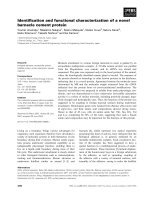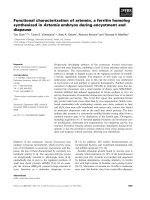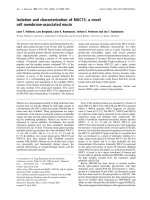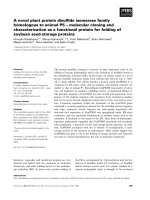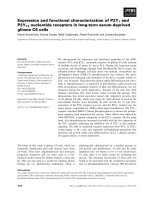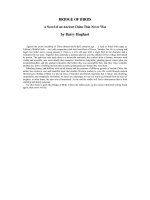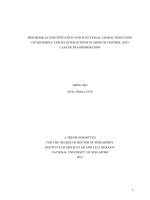Functional characterization of isthmin, a novel secreted protein in angiogenesis
Bạn đang xem bản rút gọn của tài liệu. Xem và tải ngay bản đầy đủ của tài liệu tại đây (3.63 MB, 259 trang )
FUNCTIONAL CHARACTERIZATION OF ISTHMIN, A NOVEL
SECRETED PROTEIN IN ANGIOGENESIS
XIANG WEI
B.Sc, Wuhan University
A THESIS SUBMITTED FOR
THE DEGREE OF DOCTOR OF PHILOSOPHY
DEPARTMENT OF BIOLOGICAL SCIENCES
NATIONAL UNIVERSITY OF SINGAPORE
2010
i
Acknowledgement
I will like to express my deepest and most sincere gratitude to my supervisor,
Associate Professor Ge Ruowen, for her continuous support, invaluable guidance and
encouragement throughout the research work and writing of the thesis. Her
intellectual contribution and logical thinking process have enhanced my knowledge,
which have been of great value to me.
I will also like to express my earnest thanks to Professor Kini, for his helpful
suggestions to my project, unwavering support as well as expert opinions on protein
expression and purification. The gratitude also goes out to the people from Professor
Kini’s laboratory, for their help in the protein purification work.
I acknowledge with appreciation the work of Dr. Zhang Yong on the identification of
ISM receptor. I also owe my gratitude to the following undergraduate students, Grace
Ho-Yuet Cheng and Ishak Darryl Irwan for their involvement in the cell assays.
Thanks go to all members, both past and present, from my laboratory for their
kindness, assistance and freindship. They are: Dr. Soheila, Dr. Soluchana, Dr. Farooq,
Dr. Ke Zhiyuan, Nilesh, Li Yan, Tan Lu wee, Jinghui, Jingyu, Huapeng, Sun Wei,
Yalu, Saran, Nithya, Winnie, Zhenyun and Chaojin etc.
I also truly acknowledge the research scholarship from National University of
Singapore (NUS) and research fund from the Biomedical Research Council (BMRC).
Finally, I will like to thank my dear husband Tan Swee Jin, for his understanding,
support and love throughout my study. To my beloved parents, Xiang Caigao and Li
Zhongnian whose boundless care and support enable me to complete this work. I wish
that we will share the delight of my accomplishment soon.
ii
TABLE OF CONTENTS
ACKNOWLEDGEMENT I
TABLE OF CONTENTS II
SUMMARY XI
LIST OF PUBLICATIONS RELATED TO THIS STUDY XIII
LIST OF FIGURES XIV
LIST OF TABLES XVII
ABBREVIATIONS XVIII
CHAPTER ONE: INTRODUCTION 1
1.1 Angiogenesis 1
1.1.1 Angiogenesis in life, diseases and medicine 3
1.1.2 Tumor angiogenesis and tumor development 4
1.1.3 Anti-angiogenic cancer therapy 6
1.2 Angiogenesis regulators 9
1.2.1 Pro-angiogenic factors 9
1.2.1.1 Vascular endothelial growth factor (VEGF) family 10
1.2.1.2 Fibroblast growth factor (FGF) family 15
1.2.2 Endogenous inhibitors of angiogenesis 16
1.2.2.1 Gene Products 17
1.2.2.2 Natural protein fragments 23
1.2.2.3 Others 24
1.3 Angiogenesis and integrins 25
iii
1.4 Angiogenesis and focal adhesions 29
1.5 Tumor angiogenesis and macrophage as well as matrix metalloproteinases
(MMPs) 31
1.6 In vitro angiogenesis assays and in vivo models of angiogenesis used in the
study 34
1.6.1 In vitro angiogenesis assays 34
1.6.2 The Directed In vivo Angiogenesis Assay (DIVAA) 36
1.6.3 Tumor angiogenesis using syngenic mouse tumor model and stably
modified tumor cell lines 37
1.6.4 Embryonic angiogenesis using zebrafish model 38
1.7 Thrombospondin type 1 repeat (TSR) domain 39
1.8 Adhesion-associated domain in MUC-4 and other proteins (AMOP) domain
41
1.9 Isthmin (ISM) 42
1.10 Thrombospondin and AMOP containing isthmin-like (TAIL) 1 43
1.11 Aim of this study 44
CHAPTER TWO: MATERIALS AND METHODS 45
2.1 Cell Culture 45
2.1.1 Isolation of Human Umbilical Vein Endothelial Cells (HUVECs) 45
2.1.2 Culture of cell lines and primary cell 46
2.1.3 Preservation of HUVECs and tumor cell lines 47
2.1.4 Quantification of cell number 47
2.2 DNA cloning techniques 48
2.2.1 Polymerase chain reaction (PCR) 48
2.2.2 DNA isolation 48
2.2.3 DNA gel electrophoresis 49
2.2.4 DNA ligation 50
2.2.5 Restriction endonuclease digestion of plasmid DNA 50
iv
2.2.6 Transformation 50
2.2.7 DNA sequence analysis 51
2.2.8 Vectors used 52
2.3 RNA isolation 54
2.3.1 RNA extraction from tissues 54
2.3.2 RNA extraction from culture cells 55
2.4 Reverse transcriptase-PCR 56
2.5 Real-time RT-PCR 56
2.6 Whole mount in situ hybridization on zebrafish embryos 57
2.6.1 Linearization of plasmid DNA 57
2.6.2 Probe synthesis and precipitation 58
2.6.3 Quantification of labeled probe 58
2.6.4 Preparation of zebrafish embryos 58
2.6.5 Proteinase K treatment 59
2.6.6 Prehybridization 59
2.6.7 Hybridization 60
2.6.8 Post-hybridization 60
2.6.9 Preparation of pre-absorbed DIG 60
2.6.10 Incubation with pre-absorbed antibodies 61
2.6.11 Color development 61
2.6 12 Mounting and photography 62
2.7 Protein isolation 63
2.7.1 Protein isolation from cell lysate 63
2.7.2 Protein isolation from tumor tissues 64
2.7.3 Collection of conditioned medium 64
2.8 Expression and purification of recombinant ISM proteins 65
v
2.8.1 IPTG induction and recombinant protein expression 65
2.8.2 Protein purification 65
2.8.3 Determination of protein concentration 66
2.8.4 Detection of protein endotoxin 66
2.9 In vitro cell assays 67
2.9.1 Acute cytotoxicity assay 67
2.9.2 EC In vitro capillary network formation 67
2.9.3 EC migration assay 68
2.9.4 EC attachment and spreading assay 68
2.9.5 EC proliferation assay 69
2.9.6 EC apoptosis assay 70
2.9.7 Binding assay 71
2.10 Western Blotting 71
2.10.1 SDS-polyacrylamide gel electrophoresis (SDS-PAGE) 72
2.10.2 Gel transfer 73
2.10.3 Immunoprobing and detection 73
2.10.4 Stripping and re-probe 74
2.11 Immunocytochemistry 74
2.12 Immunoprecipitation(IP) 75
2.12.1 Antibody conjugation 75
2.12.2 Lysate preclear and IP 76
2.13 Transfection 76
2.13.1 Determination of zeocin sensitivity of tumor cells 76
2.13.2 Lipid transfection 77
2.13.3 Selection of stable expression clones 77
2.14 In vivo pathological angiogenesis models 78
vi
2.14.1 Animals 78
2.14.2 Directed In Vivo Angiogenesis Assay 78
2.14.3 Subcutaneous tumor model 79
2.15 Immunohistochemistry 79
2.15.1 Fixation 79
2.15.2 Embedding 79
2.15.3 Sectioning 80
2.15.4 Dewax and rehydration 80
2.15.5 Antigen retrieval 81
2.15.6 Immunohistochemistry 81
2.15.7 TUNEL 81
2.15.8 Microvessel density (MVD) 82
2.16 In vivo physiological angiogenesis model 83
2.16.1 Zebrafish maintenance 83
2.16.2 Microinjection of morpholino oligonucleotide (MO) into embryos 83
2.16.3 Design of MO 84
2.17 Statistical analysis 84
2.18 Lists of primers and morpholino oligos 84
CHAPTER THREE: RESULTS PART I 86
3. Characterization of the role of ISM EC cell angiogenesis 86
3.1 Generation of recombinant mouse ISM and its truncated proteins 86
3.1.1 Comparison of ISM Proteins in vertebrates 86
3.1.2 Cloning, expression and purification of recombinant mouse ISM and its
truncated fragments in E.coli 87
3.1.3 Determination of endotoxin level in recombinant ISM proteins 89
3.1.4 Determination of acute cytotoxicity of the recombinant ISM proteins 90
vii
3.2 ISM inhibited various aspects of angiogenesis in vitro 92
3.2.1 ISM inhibited in vitro capillary network formation in a time-dependent
manner 92
3.2.2 ISM had no effect on VEGF, bFGF or serum stimulated EC migration .95
3.2.3 ISM did not interfere with EC attachment and spreading onto ECM 99
3.2.4 ISM inhibited VEGF, bFGF or serum-stimulated EC proliferation 103
3.2.5 ISM stimulated EC apoptosis in the presence of VEGF, bFGF or serum
105
3.3 Different anti-angiogenic activities of ISM require different functional
domain 107
3.3.1 Only ISM-C inhibited in vitro capillary network formation in a time-
dependent manner 107
3.3.2 Truncated ISM proteins did not influence EC migration 109
3.3.3 ISM truncates had no effect on EC attachment to matrix 110
3.3.4 ISM-N and ISM-C mildly inhibited VEGF-stimulated EC proliferation
111
3.3.5 None of ISM truncates induced EC apoptosis 112
3.4 The effect of ISM on other cell types 114
3.4.1 ISM mildly inhibited serum-stimulated fibroblast proliferation 114
3.4.2 ISM did not influence serum-stimulated tumor cell proliferation 116
3.4.3 ISM marginally induced fibroblast apoptosis 117
3.4.4 ISM did not affect tumor cell apoptosis 119
3.5 ISM but not ISM-C inhibited angiogenesis in vivo 121
CHAPTER FOUR: RESULTS PART II 124
4. ISM inhibited angiogenesis through multiple mechanisms 124
4.1 Interaction between ISM and integrin αvβ5 125
4.1.1 ECs bind to immobilized ISM and ISM-C but not ISM-N 125
4.1.2 ISM bound to ECs through integrin αvβ5 127
viii
4.2 ISM disrupted EC focal adhesions 130
4.2.1 ISM inhibited VEGF-stimulated FAK phosphorylation 131
4.2.2 ISM inhibited paxillin relocation into EC focal adhesions 132
4.2.3 ISM inhibited VEGF-induced actin stress fiber formation 134
4.3 ISM induced EC apoptosis through Caspase -dependent pathway 136
4.3.1 Caspase inhibitor abolished the ability of ISM in inducing EC apoptosis
136
4.3.2 ISM promoted EC Caspase 3 activation 137
CHAPTER FIVE: RESULTS PART III 139
5. Characterization of the role of ISM in tumor angiogenesis in mouse 139
5.1 ISM expression in human and mouse 139
5.1.1 Expression analyses of ISM in human tissues and tumors 139
5.1.2 Expression analyses of ISM in mouse tissue 141
5.2 Establishment of stable cell lines overexpressing ISM 143
5.3 In vitro characteristics of ISM overexpressing B16 cells 147
5.3.1 Overexpression of ISM did not affect B16 cells proliferation in vitro 147
5.3.2 Overexpression of ISM did not affect apoptosis of B16 cells in vitro 147
5.4 Overexpression of ISM in B16 cells suppressed tumor growth via inhibiting
tumor angiogenesis 149
5.4.1Tumor growth was reduced in ISM-overexpressing tumors 149
5.4.2 Microvessel density was reduced in ISM-overexpressing B16 tumors.152
5.5 Investigating the mechanisms of how ISM inhibited B16 tumor growth and
angiogenesis 154
5.5.1 Tumor cell proliferation was not altered in ISM-overexpressing B16
tumors 154
5.5.2 Tumor cell apoptosis was increased in ISM-overexpressing B16 tumors
156
ix
5.5.3 Infiltration of tumor associated macrophages (TAMs) was reduced in
ISM-overexpressing B16 tumors 158
5.5.4 VEGF expression was not affected in tumors that overexpress ISM 159
CHAPTER SIX: RESULTS PART IV 160
6. Characterization of the role of ISM in embryonic angiogenesis in zebrafish
160
6.1 Bioinformatic analyses of ISM gene(s) in zebrafish 160
6.1.1 Sequence analyses of zebrafish ism, ism2 and LOC100002267 160
6.1.2 Phylogenetic analyses of zebrafish Ism1, Ism2 and LOC100002267 163
6.1.3 Synteny analyses of zebrafish ism, tail1a and tail1b 164
6.2 Expression analyses of zebrafish ism, tail1a and tail1b 168
6.2.1 Temporal and spatial expression analysis 168
6.2.2 Adult Tissue expression pattern analyses 173
6.3 Functional study of ism, tail1a and tail1b in zebrafish embryonic
angiogenesis 175
6.3.1 ism was required for proper embryonic growth, development and survival
175
6.3.2 Knockdown of ism led to angiogenic defects 179
6.3.3 Knockdown of tail1a had no obvious effect on gross embryonic
morphology and vascular development 182
6.3.4 Knockdown of tail1b had no obvious effect on gross morphology and
vascular development 185
6.3.5 Double knockdown of ism, tail1a or tail1b 188
CHAPTER SEVEN: DISCUSSION 192
7.1 The position of ISM in angiogenesis inhibitors known so far 194
7.2 The role of ISM in physiological angiogenesis 198
7.3 The role of ISM in pathological angiogenesis 203
7.4 Possible mechanisms of action of ISM in angiogenesis 207
x
7.5 Other roles of ISM 212
7.6 Prospect of ISM as a therapeutic agent in cancer treatment 214
7.7 Conclusions 216
7.8 Future perspectives 218
REFERENCES 221
xi
Summary
Anti-angiogenesis represents a promising therapeutic strategy for the treatment of
various malignancies. Although several proteins have been identified to inhibit
angiogenesis, it is conceivable that many genes regulating angiogenesis in vivo have
yet to be discovered. In this study, we aim to identify a novel endogenous
angiogenesis inhibitor and characterize its function in in vivo angiogenesis.
Isthmin (ISM) is a secreted 60 kDa protein containing a Thrombospondin Type 1
Repeat (TSR) domain and an Adhesion-associated domain in MUC4 and Other
Proteins (AMOP) domain with no known functions. The role of ISM is investigated in
angiogenesis using in vitro angiogenesis cell assays, mouse tumor and embryonic
zebrafish models.
Recombinant mouse ISM inhibits endothelial cell (EC) capillary network formation
on Matrigel. It also suppresses VEGF-bFGF induced in vivo angiogenesis in mouse. It
mitigates various growth factors-stimulated EC proliferation without affecting EC
migration. Furthermore, ISM induces EC apoptosis in the presence of VEGF through
a Caspase -dependent pathway.
Mechanism studies indicate that ISM binds to vβ5 integrin on the EC surface,
interfering integrin αvβ5/focal adhesion complex/actin skeleton pathway downstream
of VEGF to inhibit EC tube formation. Structure-functional analysis demonstrates the
important role of the AMOP domain but not TSR domain in the anti-angiogenic
function of ISM.
xii
Overexpression of ISM significantly suppresses B16 melanoma tumor growth via
inhibition of tumor angiogenesis. In addition, ISM inhibits tumor angiogenesis by
inhibiting TAM infiltration without affecting the expression level of VEGF in tumors.
The expression and function of all three zebrafish ism family gene members during
embryonic development are analyzed. ism has maternal expression and is expressed
dynamically whereas tail1a and tail1b starts to express at 24 hpf and is expressed
persistently. Knockdown of ism in zebrafish embryos using MO leads to disorganized
ISVs in the trunk. Furthermore, ism is required for the survival and development of
zebrafish embryos. However, knocking down of tail1a or tail1b does not result in any
significant gross morphological phenotypes during the zebrafish development. These
results indicate distinct expression and function of the ism family genes.
Therefore, our results demonstrate that ISM is a novel endogenous angiogenesis
inhibitor with functions likely in physiological as well as pathological angiogenesis.
This work expands the understanding of the regulatory mechanisms of angiogenesis
in physiological and pathological conditions, and provides a novel therapeutic agent
for the treatment of cancer.
xiii
LIST OF PUBLICATIONS RELATED TO THIS STUDY
Xiang W, Ke Z, Zhang Y, Cheng GH, Irwan ID, Sulochana KN, Potturi P, Wang Z,
Yang H, Wang J, Zhuo L, Kini RM, Ge R. Isthmin is a novel secreted angiogenesis
inhibitor that inhibits tumor growth in mice. J. Cell. Mol. Med. 2009 Oct 29. [Epub
ahead of print] PMID: 19874420.
xiv
List of Figures
Fig. 1.1 The process of angiogenesis 2
Fig. 1.2 Binding specificity of various VEGF family members and their receptors. 13
Fig. 1.3 Schematic illustration of VEGFR-2 intracellular signaling. 14
Fig. 1.4 Signaling pathways initiated by integrins at focal contacts 28
Fig. 2.1 pGEM®-T easy vector map. 53
Fig. 2.2 Plasmid map of pET-32a 53
Fig. 2.3 pSecTag2A, B, C vector map 54
Fig. 3.1 Sequence comparison, expression and purification of recombinant mouse
ISM and its truncated fragments 88
Fig. 3.2 Acute cytotoxicity of recombinant ISM and its truncated proteins to ECs 91
Fig. 3.3 ISM inhibited EC capillary network formation in both dose-dependent and
time-dependent manners 94
Fig 3.4 ISM did not influence VEGF, bFGF or serum stimulated EC chemotaxis. 97
Fig 3.5 ISM did not influence EC chemokinesis in the absence or presence of VEGF.
98
Fig. 3.6 ISM did not interfere with EC attachment to gelatin, fibronectin or diluted
Matrigel 101
Fig. 3.7 ISM did not influence EC spreading on gelatin-coated surface. 102
Fig. 3.8 ISM inhibited multiple growth factors-stimulated EC proliferation in a dose-
dependent manner. 104
Fig. 3.9 ISM induced EC apoptosis in the presence of VEGF, bFGF or serum 106
Fig. 3.10 ISM-C but not other ISM truncated forms inhibited in vitro capillary
network formation 108
Fig. 3.11 ISM truncates had no effect on VEGF-stimulated EC chemotaxis 109
Fig. 3.12 ISM truncates had no effect on EC attachment to gelatin. 110
Fig. 3.13 ISM-N and ISM-C mildly inhibited VEGF-stimulated EC proliferation 111
Fig. 3.14 None of the ISM truncates induced EC apoptosis 113
xv
Fig. 3.15 ISM mildly but significantly inhibited fibroblast cells proliferation 115
Fig. 3.16 ISM did not affect serum-stimulated tumor cell proliferation 116
Fig. 3.17 ISM marginally induced fibroblast cells apoptosis. 118
Fig. 3.18 ISM had no effect on tumor cells apoptosis. 120
Fig. 3.19 ISM suppresses angiogenesis in vivo 123
Fig. 4.1 ECs binds to immobilized ISM and ISM-C but not ISM-N 126
Fig. 4.2 ISM bound to αvβ5 integrin on ECs 129
Fig. 4.3 ISM inhibited VEGF-stimulated FAK phosphorylation in a dose-dependent
manner 131
Fig. 4.4 ISM inhibited VEGF-stimulated paxillin clustering and recruitment to plasma
membrane focal adhesions 133
Fig. 4.5 ISM inhibited VEGF-induced stress fiber formation. 135
Fig. 4.6 ISM induced EC apoptosis in the presence of VEGF through Caspase -
dependent pathway 138
Fig. 4.7 ISM promoted activation of Caspase 3 in the presence of VEGF in a dose
dependent manner. 138
Fig. 5.1 Expression of ISM in human normal and tumor tissues 140
Fig. 5.2 Tissue expression analyses of ISM mRNA. 142
Fig. 5.3 Endogenous ISM expression level in various tumor cell lines 145
Fig. 5.4 Selection of ISM-overexpressing B16 stable cell lines 146
Fig. 5.5 Growth kinetics of stable cell lines 148
5.6 Apoptosis of stable cell lines. 148
Fig. 5.7 Overexpression of ISM resulted in reduction of B16 tumor growth in mice.
150
Fig. 5.8 Overexpression of ISM inhibited tumor growth in vivo 151
Fig. 5.9 B16/ISM tumors show a reduced vascularization compared to controls. 153
Fig. 5.10 There was no significant difference of tumor proliferation between control
and ISM-overexpressing tumors 155
xvi
Fig. 5.11 Increased apoptotic tumor cells were observed in ISM-overexpressing
tumors. 157
Fig. 5.12 TAMs infiltration was decreased in ISM-overexpressing tumors 158
Fig. 5.13 Overexpression of ISM did not influence VEGF expression in tumors 159
Fig. 6.1 Comparison of the domains of zebrafish Ism, Ism2 and LOC100002267 with
human ISM 161
Fig. 6.2 Amino acid sequence alignment of the zebrafish Ism with zebrafish Ism2,
LOC100002267 and human ISM 162
Fig. 6.3 Phylogenetic analysis of Ism in vertebrates. 164
Fig. 6.4 Syntenic analysis of zebrafish ism, tail1a and tail1b. 167
Fig. 6.5 Temporal expression level of zebrafish ism, tail1a and tail1b in wild-type
embryos 171
Fig. 6.6 Expression pattern of zebrafish ism during embryogenesis detected by WISH.
172
Fig. 6.7 Tissue expression pattern of zebrafish ism, tail1a and tail1b 174
Fig. 6.8 ism was required for proper embryonic growth, development and survival.178
Fig. 6.9 ism morphants showed angiogenic defects 181
Fig. 6.10 No obvious phenotypes were observed in tail1a morphants 183
Fig. 6.11 No obvious morphological defects of ISVs were observed in tail1a
morphants 184
Fig. 6.12 No abnormal gross morphology was observed in tail1b morphants. 186
Fig. 6.13 No abnormal vasculogenesis or angiogenesis was observed in tail1b
morphants 187
Fig. 6.14. The effect of double knockdown ism and tail1a in zebrafish embryos 190
Fig. 6.15. The effect of double knockdown ism and tail1b in zebrafish embryos 191
Fig. 6.16. The effect of double knockdown tail1a and tail1b in zebrafish embryos. 191
Fig. 7.1 Model of the construction of a zebrafish ISV 202
Fig. 7.2 Illustration of the anti-angiogenic mechanisms of the action ISM in ECs 211
xvii
List of Tables
Table 1.1 List of Known Pro-angiogenic Factors 10
Table 1.2 List of Known Endogenous Angiogenesis Inhibitors 16
Table 1.3 Vascular integrins in angiogenesis 27
Table 3.1 Summary of the aimono acid identities of TSR and AMOP domains of ISM
among different vertebrate species 87
Table 3.2 Summary of recombinant ISMs purification 89
Table 6.1 Summary of major phenotypes in embryos injected with 0.77 pmol ism
ATG MO or ism splice MO 178
Table 7.1. Summary of the function of ISM and its various domains in in vitro
angiogenesis 197
xviii
Abbreviations
ADAMTS a disintegrin and metalloproteinases with thrombospondin motifs
AMOP adhesion-associated domain in MUC-4 and other proteins
bFGF basic fibroblast growth factor
CAM chick chorioallantoic membrane
ChM-I chondromodulin-I
DA dorsal aorta
DIVAA the directed in vivo angiogenesis assay
DLAVs dorsal longitudinal anastamotic vessels
EC endothelial cell
ECM extracellular matrix
EGF epidermal growth factor
EHS engelbreth-holm-swarm
eNOS endothelial nitric oxide synthase
FAK focal adhesion kinase
GFP green fluorescent protein
HUVEC human umbilical vascular endothelial cell
IGF-1 insulin-like growth factor-1
IFNs interferons
ILs interleukins
ISM isthmin
ISVs intersegmental vessels
MAPK mitogen-activated protein kinase
MCP-1 monocyte chemotactic protein-1
M-CSF macrophage colony stimulating factor
MMP matrix metalloproteinase
MO morpholino oligonucleotide
NRP neuropilin
PCV posterior cardinal vein
PDEF pigment epithelium derived factor
PF-4 platelet factor-4
PI3K phosphatidylinositol 3 kinase
TAIL1 thrombospondin and AMOP containing isthmin-like 1
TAMs tumor-associated macrophages
TGF transforming growth factor
Tn-I troponin I
TSPs thrombospondins
TSR thrombospondin type 1 repeat
VEGF vascular endothelial growth factor
VEGFR vascular endothelial growth factor receptor
1
Chapter One: Introduction
1.1 Angiogenesis
Angiogenesis, derived from the Greek word angêion meaning vase, and genesis
meaning birth, is the name given to the outgrowth of new capillaries from the pre-
existing primary blood vessels (Folkman, et al., 1992). It comprises two different
mechanisms: endothelial sprouting and non-sprouting with the former as the dominant
form (Risau, 1997).
During sprouting angiogenesis, vascular plexus progress by sprouting and remodeling
into a highly organized vascular network. It is a complex process involving multiple
steps including degradation of existing extracellular matrix (ECM), endothelial cell
(EC) proliferation and migration, capillary tube formation and secretion of new ECM.
The newly formed immature capillaries are stabilized by recruitment of supporting
cells such as pericytes in smaller vessels and smooth muscle cells in larger vessels for
functional perfusion (Fig. 1.1A) (Carmeliet, 2000).
Non-sprouting angiogenesis is a process of dividing pre-existing vessels by formation
and insertion of endothelial columns into the vessel lumen. It mainly has three phases
including: 1) establishment of a contact zone within the two opposing capillary walls,
2) reorganization of the EC junctions and the perforation of the vessel bilayer, 3) core
formation between the two new vessels at the zone of contact (Fig. 1.1B) (Frontczak-
Baniewicz, et al., 2002). The subsequent growth and stabilization of these pillars
result in partitioning of the vessel and remodeling of the local vascular network
(Risau, 1997).
Fig. 1.1 The process of angiogenesis.
A) Sprouting angiogenesis: formation of blood
vessels is a multi-step process, which includes (i) reception of angiogenic signals
(yellow spot) from the surrounding by endothelial cells (EC); (ii) retraction of
pericytes from the abluminal surface of capillary and secretion of protease from
activated endothelial cells (aEC) and proteolytic degradation of extracellular
membrane (green dash-line); (iii) chemotactic migration of EC under the induction of
angiogenic stimulators; (iv) proliferation of EC and formation of lumen/canalisation
by fusion of formed vessels with formation of tight junctions; (v) recruitment of
pericytes and deposition of new basement membrane and initiation of blood flow. B)
Non-sprouting angiogenesis – intussusceptive microvascular growth: it is initiated by
(i) protrusion of opposing capillary walls towards the lumen; (ii) perforation of the EC
bilayer and formation of many transcapillaries with interstitial core (red arrow); (iii)
formation of the vascular tree from intussusceptive pillar formation and pillar fusion
and elongation of capillaries (green arrows). (Adapted from Yue et al. Chinese
Medicine 2007 2:6)
2
3
1.1.1 Angiogenesis in life, diseases and medicine
Most angiogenesis occurs in the embryos to form vascular network to provide the
growing organs with the necessary oxygen and nutrient. After birth, angiogenesis still
contributes to organ growth but, during adulthood, most blood vessels remain
quiescent and angiogenesis occurs only in specific physiological conditions such as
female reproductive cycles, wound healing as well as in the placenta during
pregnancy (Arnold, et al., 1991).
When angiogenesis is dysregulated, it has a major impact on health and contributes to
the pathologenesis of many disorders. Insufficient angiogenesis not only causes heart
and brain ischemia, but can also lead to neurodegeneration, respiratory distress and
gastric or oral ulcerations. On the other hand, many common disorders are caused by
excessive angiogenesis including obesity, atherosclerosis, psoriasis, arthritis,
blindness (Rupnick, et al., 2002) and cancer (Folkman, 1992).
The essential role of angiogenesis in many pathogenic processes indicates the
potential for developing new therapeutic strategies for all the diseases associated with
pathological angiogenesis. Clinical trials have shown some promise in the patient with
cardiovascular disease by stimulating angiogenesis (Ahn, et al., 2008,Al Sabti,
2007,Simons, 2005) and patients with solid tumor (specially breast, colorectal and
lung cancers) experienced benefits in overall survival when combining conventional
chemotherapy and anti-angiogenic therapy (Jain, et al., 2006). Pro-angiogenic and
anti-angiogenic are emerging as novel, promising and challenging therapies in the
current medicine. Knowledge of molecular and cellular mechanism of angiogenesis
will facilitate to fully exploit their therapeutic potential.
4
1.1.2 Tumor angiogenesis and tumor development
The complex network of tumor blood microvessels guarantees adequate supply of
tumor cells with nutrients and oxygen and provides efficient drainage of metabolites.
Based on the knowledge that tumor cannot grow beyond 1-2 mm
3
in an avascular
state, the surgeon Judah Folkman was the first to hypothesize that targeting the blood
vessels will lead to arrest of tumor growth or even shrinkage in the 1970s (Folkman,
1971). This hypothesis was later confirmed experimentally by many studies (Folkman,
1992,Folkman, et al., 1971,Norrby, 1997). Angiogenesis also facilitates tumor
metastases by providing an efficient exit route for tumor cells to leave the primary site
and enter the blood stream (Zhang, et al., 2009). Experimental and clinical studies
have shown that primary tumors as well as metastases can remain dormant for years.
However, most tumors escape dormancy once angiogenesis occurs (Narazaki, et al.,
2006,Naumov, et al., 2006,Tosetti, et al., 2002). In addition, the degree of tumor
vascularization is correlated with tumor grade as well as aggressiveness, which serves
as a significant clinical prognosis indicator (Sarbia, et al., 1996,Tanigawa, et al.,
1996).
The angiogenic switch controlled by a net balance of positive and negative regulators,
is the initiation of tumor angiogenesis(Hanahan, et al., 1996). The angiogenic cascade
includes an activation and resolution phase. In the activation phase, tumors release
diffusible activators of angiogenesis to the surrounding tissues and induce phenotypic
changes in ECs as well as in other cell types. Proteases, heparanase and other
digestive enzymes are released by endothelial and tumor cells to degrade capillary
basement membrane. ECs in the surrounding tissues then migrate, proliferate and
differentiate to form capillaries. In the subsequent resolution phase, maturation and
5
stabilization of the newly formed vessels were achieved by pericytes association,
basement membrane construction and junction complex formation (Kurz, et al., 2002).
However, tumor ECs are different from normal ECs in gene expression profile,
behavior, as well as morphology (Hida, et al., 2008). Tumor ECs have relatively
larger nuclei than normal ECs, indicating they have more DNA content. A certain
percentage of tumor ECs are karyotypically aneuploid (e.g. 16% of liposarcoma ECs,
34% of melanoma ECs, 54% of renal carcinoma ECs) whereas normal ECs are
diploid. In addition, there is upregulation of adhesion molecules such as CD31 or
ICAM-1 in lung carcinoma ECs compared to normal ECs (Hida, et al., 2008).
Morphologically, tumor vessels are highly disorganized with irregular shape, uneven
diameter and excessive branching and shunts whereas the normal vasculature shows a
hierarchal branching pattern (McDonald, et al., 2003). The tumor vessel walls might
be lined by cancer cells or a mosaic of cancer cells and ECs instead of single layer of
ECs (Chang, et al., 2000). Tumor vessel basement membranes have structural
abnormalities including loose associations with ECs, and varying thicknesses of type
IV collagen layers (Kalluri, 2003). Tumor vessels are also leaky and hyperpremeable
to circulating macromolecules (Feng, et al., 2000). Consequently, tumor blood flow is
chaotic and variable, and leads to hypoxic (decreased O
2
) and acidic regions
(increased CO
2
) inside tumors (Helmlinger, et al., 1997).
In conclusion, tumor angiogenesis is necessary for the solid tumor progression and
metastasis. However, different from physiological angiogenesis, tumor angiogenesis
has its specific biological characteristic that might be considered in the development
of anti-angiogenic cancer therapy.
6
1.1.3 Anti-angiogenic cancer therapy
Since tumor growth and metastasis are angiogenesis dependent, angiogenesis
inhibition has attracted a lot of attention as a treatment method of cancer. Targeting
ECs rather than cancer cells themselves, is a relatively new but particularly promising
approach to cancer therapy because (1) the ECs are located in the most inner layer of
blood vessels, therefore systemically administered drugs are easily accessible to ECs
so that the problem of low penetration of the antitumoral drugs into solid tumors can
be avoided (Gasparini, 1999); (2) a single vascular net may support the growth of
more than one population of cells in tumor, thus, targeting ECs might be a much more
effective strategy than targeting tumor cells (Kerbel, 1997); (3) the expression of
specific markers by activated endothelium, such as integrin αvβ3, E-selectin, and
vascular endothelium growth factor (VEGF) receptors, could be used to confer
specificity to anti-angiogenic therapies and (4) tumor ECs are similar among most
tumor types, an ideal anti-angiogenic drug could be useful in treating many cancers.
During the past decades, intensive efforts have been undertaken to develop anti-
angiogenic therapy with more than 40,000 scientific papers published on this subject,
and hundreds of molecules with anti-angiogenic activity in preclinical models have
been reported and many have entered clinical testing in cancer treatment (Quesada, et
al., 2006). In addition, numerous vascular endothelium-specific drug targeting
strategies were developed including gene therapies (viral and non-viral approach),
siRNAs, antisense oligodeoxynucleotides, as well as chemical inhibitors of signal
transduction (Molema, 2005).
To date, four anti-angiogenic drugs have been approved by the Food and Drug
Administration (FDA) of USA for the clinical use for patients with solid tumors
